Structural and Spectroscopic Characteristics of NiII and CuII Complexes with Poly (Vinyl Alcohol-Nicotinic Acid) Copolymers for Photocatalytic Degradation of Indigo Carmine Dye
Abstract
:1. Introduction
2. Materials and Methods
2.1. Materials & Instruments
2.1.1. Synthesis of Copolymer
2.1.2. Synthesis of M/PVA-NA Complexes
2.2. Catalytic Activity
2.2.1. Decolorization in Air (Adsorption)
2.2.2. Photocatalytic Evaluation
2.3. Molecular Modeling Study & Computational Model
3. Results &Discussion
3.1. NMR
3.2. IR Spectra
3.3. UV–Visible and EPR Spectra
3.4. Thermal Analysis
3.5. XRD Studies
3.6. Band Gap
3.7. Photocatalytic Activity
3.8. Molecular Modeling Studies
3.8.1. Molecular Geometry
3.8.2. Stability Inter- and Intra-Molecular Interaction Stability
- (i)
- Chemical Reactivity & Frontier orbital analysis
- (ii)
- Molecular electrostatic potential map (EPM)
- (iii)
- The Local Reactivity profile
3.8.3. Hirshfeld Fingerprint
3.8.4. Nonlinear Optical Effects
4. Conclusions
- PVA was successfully modified with nicotinic acid, yielding graft copolymers.
- FT-IR and NMR spectroscopy confirmed the distribution of NA onto PVA, and the coordinating of copolymer with the M-ion.
- The ESR spectra showed the distorted square planar structure in NiII/PVA-NA and CuII/PVA-NA complexes.
- Incorporation of NiII and CuII into PVA-NA plays an advantageous role in the thermal stability through ionic interaction. Thus, the NiII and CuII copolymers become better blending agents than PVA-NA itself.
- The adsorption of IC dye onto CuII/NA-PVA complex was noticeably greater (90%) in 35 min.
- The simulated FMOs showed that the ligand and copolymers are promising nucleophiles with high ability for receiving electrons from dye is related to the distribution of M-ions into PVA-NA; this occurs due to electron transfer between aliphatic chain of PVA-NA and M-core.
- The EPMs showed that the electrophilic site for these copolymers recognized the nucleophile region of the dye.
- The ΔNmax for copolymers demonstrated that the charge migrates as Ligand → Dye.
- NLO studies introduce a clear picture of promising optical properties compared to standard material.
Supplementary Materials
Author Contributions
Funding
Institutional Review Board Statement
Informed Consent Statement
Data Availability Statement
Conflicts of Interest
References
- Klaus, H. Industrial Dyes-Chemistry, Properties, Applications; Wiley-VCH: Weinheim, Germany, 2003. [Google Scholar]
- Dąbrowski, A. Adsorption—from theory to practice. Adv. Colloid Interf. Sci. 2001, 93, 135–244. [Google Scholar] [CrossRef]
- Reife, A. Dyes, environmental chemistry. In Kirk-Othmer Encyclopedia of Chemical Technology; JohnWiley & Sons: Hoboken, NJ, USA, 2000. [Google Scholar]
- Olness, A. Water Quality: Prevention, Identification and Management of Diffuse Pollution. J. Environ. Qual. 1995, 24, 383. [Google Scholar] [CrossRef]
- Zollinger, H. Color Chemistry: Synthesis, Properties and Applications of Organic Dyes and Pigments, 2nd ed.; VCH Publisher: New York, NY, USA, 1991. [Google Scholar]
- Cang-Rong, J.T.; Pastorin, G. The influence of carbon nanotubes on enzyme activity and structure: Investigation of different immobilization procedures through enzyme kinetics and circular dichroism studies. Nanotechnology 2009, 20, 255102. [Google Scholar] [CrossRef]
- Golder, A.K.; Samanta, A.N.; Ray, S. Anionic reactive dye removal from aqueous solution using a new adsorbent—Sludge generated in removal of heavy metal by electrocoagulation. Chem. Eng. J. 2006, 122, 107–115. [Google Scholar] [CrossRef]
- Zhang, S.F.; Xiong, F.; He, Z.; Liang, Y.; Xue, J.R.; Jing, L.H.; Qin, D.B. Syntheses, structures, luminescent and gas adsorption properties of five new interpenetrated, 2D and 3D metal–organic frameworks based on a semi-rigid bis (imidazole)-carbazole ligand. Polyhedron 2015, 102, 401. [Google Scholar] [CrossRef]
- Wang, F.; Wang, C.; Yu, Z.; Xu, K.; Li, X.; Fu, Y. Two multifunctional Mn (II) metal–organic frameworks: Synthesis, structures and applications as photocatalysis and luminescent sensor. Polyhedron 2016, 105, 49. [Google Scholar] [CrossRef]
- Xie, W.F.; Guo, L.Y.; Xu, J.H.; Jagodič, M.; Jagličić, Z.; Wang, W.G.; Zhuang, G.L.; Wang, Z.; Tung, C.H.; Sun, D. Multifaceted bicubane Co4 clusters: Magnetism, photocatalytic oxygen evolution, and electrical conductivity. Eur. J. Inorg. Chem. 2016, 20, 3253. [Google Scholar] [CrossRef]
- Yan, Z.H.; Li, X.Y.; Liu, L.W.; Yu, S.Q.; Wang, X.P.; Sun, D. Single-crystal to single-crystal phase transition and segmented thermochromic luminescence in a dynamic 3D interpenetrated AgI coordination network. Inorg. Chem. 2016, 55, 1096. [Google Scholar] [CrossRef] [PubMed]
- Kaliyappan, T.; Kannan, P. Co-ordination polymers. Prog. Polym. Sci. 2000, 25, 343–370. [Google Scholar] [CrossRef]
- Hu, T.; Wang, X.; Xue, Z.; Zhang, X.; Wang, X. Structural control and magnetic properties of three Co (II) coordination polymers based on 6-(3, 5-dicarboxylphenyl) nicotinic acid. Polyhedron 2017, 127, 449–457. [Google Scholar] [CrossRef]
- Lim, M.; Kwon, H.; Kim, D.; Seo, J.; Han, H.; Khan, S.B. Highly-enhanced water resistant and oxygen barrier properties of cross-linked poly (vinyl alcohol) hybrid films for packaging applications. Prog. Org. Coat. 2015, 85, 68–75. [Google Scholar] [CrossRef]
- Carlotti, S.J.; Giani-Beaune, O.; Schué, F. Characterization and mechanical properties of water-soluble poly (vinyl alcohol) grafted with lactic acid and glycolic acid. J. Appl. Polym. Sci. 2001, 80, 142–147. [Google Scholar] [CrossRef]
- Son, B.; Yeom, B.Y.; Song, S.H.; Lee, C.S.; Hwang, T.S. Antibacterial electrospun chitosan/poly (vinyl alcohol) nanofibers containing silver nitrate and titanium dioxide. J. Appl. Polym. Sci. 2008, 111, 2892–2899. [Google Scholar] [CrossRef]
- Hnatejko, Z.; Dutkiewicz, G.; Kubicki, M.; Lis, S. New complexes of cobalt (II) ions with pyridinecarboxylic acid N-oxides and 4, 4′-byp. J. Mol. Struct. 2013, 1034, 128–133. [Google Scholar] [CrossRef]
- Marandi, F.; Moeini, K.; Ghasemzadeh, S.; Mardani, Z.; Quah, C.K.; Loh, W.S. Synthesis, spectral and X-ray diffraction of two new 2D lead (II) coordination polymers formed by nicotinic acid N-oxide linkers. J. Mol. Struct. 2017, 1149, 92–98. [Google Scholar] [CrossRef]
- Marandi, F.; Quah, C.K.; Hoong-Kun, F. The first crystal structures of two 2-D lead (II)-coordination polymers with picolinic acid N-oxide and pseudohalides extended to 3-D networks by intermolecular interactions. J. Coord. Chem. 2013, 66, 986–994. [Google Scholar] [CrossRef]
- Singh, R.; Rao, R.S.S. Synthesis and characterization of divalent manganese, cobalt, nickel, copper and zinc complexes with nicotinic acid. J. Mol. Struct. 1981, 71, 23–30. [Google Scholar] [CrossRef]
- Gimenez, V.; Mantecon, A.; Ronda, J.C.; Cadiz, V. Poly (vinyl alcohol) modified with carboxylic acid anhydrides: Crosslinking through carboxylic groups. Appl. Polym. Sci. 1997, 65, 1643–1651. [Google Scholar] [CrossRef]
- Şenel, M.; Bozkurt, A.; Baykal, A. An investigation of the proton conductivities of hydrated poly (vinyl alcohol)/boric acid complex electrolytes. Ionics 2007, 13, 263. [Google Scholar] [CrossRef]
- Serna, C.; Fornes, V.; Fernandez-Navarro, J.M. Sol gel transition in simple Silisate. J. Non-Cryst. Solids 1984, 63, 45. [Google Scholar]
- Patel, R.N.; Gundla, V.L.N.; Patel, D.K. Synthesis, characterization and properties of some ternary copper (II) complexes containing NOS donor Schiff base and NN donor bidentate ligands. Indian J. Chem. 2008, 47, 353. [Google Scholar]
- Lever, A. Inorganic Electronic Spectroscopy, 2nd ed.; Elsevier: Amsterdam, The Netherlands, 1984. [Google Scholar]
- Singh, O.I.; Damayanti, M.; Singh, N.R.; Singh, R.H.; Mohapatra, M.; Kadam, R.M. Synthesis, EPR and biological activities of bis (1-n-butylamidino-O-alkylurea) copper (II) chloride complexes: EPR evidence for binuclear complexes in frozen DMF solution. Polyhedron 2005, 24, 909–916. [Google Scholar] [CrossRef]
- El-Boraey, H.; Abdel-Rahman, R.; Atia, E.; Hilmy, K. Spectroscopic, thermal and toxicity studies of some 2-amino—3-cyano—1, 5-diphenylpyrrole containing Schiff bases copper (II) complexes. Open Chem. 2010, 8, 820–833. [Google Scholar] [CrossRef]
- Raman, N.; Jeyamurugan, R.; Subbulakshmi, M.; Boominathan, R.; Yuvarajan, C.R. Synthesis, DNA binding, and antimicrobial studies of novel metal complexes containing a pyrazolone derivative Schiff base. Chem. Pap. 2010, 64, 318–328. [Google Scholar] [CrossRef]
- Pai, S.; Newalkar, B.; Choudary, N. Synthesis and characterization of cobalt substituted aluminophosphate molecular sieve: Co-SSZ-51 under microwave-hydrothermal conditions. Microporous Mesoporous Mater. 2006, 96, 135. [Google Scholar] [CrossRef]
- Duan, F.; Chen, J.P.; Yu, J.; Xu, R. A low-cost route to the syntheses of microporous cobalt-substituted aluminophosphates by using the waste mother-liquor. Microporous Mesoporous Mater. 2009, 126, 26. [Google Scholar] [CrossRef]
- Coats, A.; Redfern, J. Kinetic parameters from Thermogravimetric data. Nature 1964, 201, 68–69. [Google Scholar] [CrossRef]
- Horowitz, H.; Metzger, G. A new analysis of thermogravimetric traces. Anal. Chem. 1963, 35, 1464. [Google Scholar] [CrossRef]
- Frost, A.; Pearson, R. Kinetics and Mech., 2nd ed.; Wiley: New York, NY, USA, 1961; p. 88. [Google Scholar]
- Othman, I. Sol–gel synthesis of NiFe2O4 with PVA matrices and their catalytic activities for one-step hydroxylation of benzene into phenol. J. Therm. Anal. Calorim. 2014, 116, 805. [Google Scholar]
- Maravalli, P.; Goudar, T. Thermal and spectral studies of 3-N-methyl-morpholino-4-amino-5-mercapto-1, 2, 4-triazole and 3-N-methyl-piperidino-4-amino-5-mercapto-1, 2, 4-triazole complexes of cobalt (II), nickel (II) and copper (II). Thermochim. Acta 1999, 325, 35. [Google Scholar] [CrossRef]
- Yusuff, K.; Sreekala, R. Thermal and spectral studies of 1-benzyl-2-phenylbenzimidazole complexes of cobalt (II). Themochim. Acta 1990, 159, 357. [Google Scholar] [CrossRef]
- Mohamed, G.; Abd El-Wahab, Z. Salisaldehyde-2-aminobenzimidazole schiff base complexes of Fe (III), Co (II), Ni (II), Cu (II), Zn (II) and Cd (II). J. Therm. Anal. Calorim. 2003, 73, 347–359. [Google Scholar] [CrossRef]
- Bhaskare, C.; Hankare, P. Cobalt-, Nickel- and Copper (II) Complexes of Schiff Bases with N or S Donor Sites. J. Ind. Chem. Soc. 1995, 72, 585. [Google Scholar]
- Donia, A.; Gouda, M.; Ayad, M.; El-Boraey, H. Synthesis and thermal characterization of new ternary chelates of piroxicam and tenoxicam with glycine and dl-phenylalanine and some transition metals. Thermohim. Acta 1992, 194, 155. [Google Scholar] [CrossRef]
- Kulkarni, S.; Kittur, A.; Aralaguppi, M.; Kariduraganavar, M. Synthesis and characterization of hybrid membranes using poly (vinyl alcohol) and tetraethylorthosilicate for the pervaporation separation of water–isopropanol mixtures. J. Appl. Polym. Sci. 2004, 94, 1304. [Google Scholar] [CrossRef]
- Isiklan, N.; Sanli, O. Separation characteristics of acetic acid–water mixtures by pervaporation using poly (vinyl alcohol) membranes modified with malic acid. Chem. Eng. Process. 2005, 44, 1019. [Google Scholar] [CrossRef]
- Wang, S.F.; Gu, F.; Lü, M.K.; Cheng, X.F.; Zou, W.G.; Zhou, G.J.; Wang, S.M.; Zhou, Y.Y. Synthesis and photoluminescence characteristics of Dy3+-doped ZnAl2O4 nanocrystals via a combustion process. J. Alloys Compd. 2005, 394, 255–258. [Google Scholar] [CrossRef]
- Bai, H.; Liu, Z.; Sun, D. Catalytic partial oxidation of isobutanol for the production of hydrogen. Int. J. Hydrogen Energy 2012, 37, 1399. [Google Scholar]
- Kislova, N.; Srinivasana, S.; Emirov, Y.; Stefanakos, E. Optical absorption red and blue shifts in ZnFe2O4 nanoparticles. Mater. Sci. Eng. B 2008, 153, 70–77. [Google Scholar] [CrossRef]
- Saha, B.; Das, S.; Chattopadhyay, K. Electrical and optical properties of Al doped cadmium oxide thin films deposited by radio frequency magnetron sputtering. Sol. Energy Mater. Sol. Cells 2007, 91, 311. [Google Scholar] [CrossRef]
- Fan, W. A Novel Carbon Nanotube Structure Formed in Ultra-Long Nanochannels of Anodic Aluminum Oxide Templates. J. Phys. Chem. B 2006, 110, 2080. [Google Scholar]
- Manikandan, A.; Durka, M.; Arul, S. Preparation and characterization of nanocopper ferrite and its green catalytic activity in alcohol oxidation reaction. J. Supercond. Nov. Magn. 2019, 32, 903–910. [Google Scholar]
- Ali, I.O.; Mostafa, A.G. Photocatalytic reduction of chromate oxyanions on MMnFe2O4 (M= Zn, Cd) nanoparticles. Mater. Sci. Semicond. Process. 2015, 33, 189–198. [Google Scholar]
- Elhenawy, A.A.; Al-Harbi, L.M.; El-Gazzar, M.A.; Khowdiary, M.M.; Moustfa, A. Synthesis, molecular properties and comparative docking and QSAR of new 2-(7-hydroxy-2-oxo-2H-chromen-4-yl) acetic acid derivatives as possible anticancer agents. Spectrochim. Acta Part A Mol. Biomol. Spectrosc. 2019, 218, 248–262. [Google Scholar] [CrossRef]
- Fukui, K. Role of frontier orbitals in chemical reactions. Science 1982, 218, 747–754. [Google Scholar] [CrossRef] [Green Version]
- Elhenawy, A.A.; Al-Harbi, L.M.; Moustafa, G.O.; El-Gazzar, M.A.; Abdel-Rahman, R.F.; Salim, A.E. Synthesis, comparative docking, and pharmacological activity of naproxen amino acid derivatives as possible anti-inflammatory and analgesic agents. Drug Des. Dev. Ther. 2019, 13, 1773–1790. [Google Scholar] [CrossRef] [Green Version]
- Wildman, S.A.; Crippen, G.M. Prediction of physicochemical parameters by atomic contributions. J. Chem. Inf. Comput. Sci. 1999, 39, 868–873. [Google Scholar] [CrossRef]
- Luque, F.J.; López, J.M.; Orozco, M. Perspective on “Electrostatic Interactions of a Solute with a Continuum. A Direct Utilization of ab Initio Molecular Potentials for the Prevision of Solvent Effects”. In Theoretical Chemistry Accounts; Springer: Cham, Switzerland, 2000; pp. 343–345. [Google Scholar]
- Komorowski, L.; Lipinski, J.; Szarek, P.; Ordon, P. Polarization justified Fukui functions: The theory and applications for molecules. J. Chem. Phys. 2011, 135, 014109. [Google Scholar] [CrossRef]
- Mendoza-Huizar, L.H.; Rios-Reyes, C.H. Chemical reactivity of atrazine employing the Fukui function. J. Mex. Chem. Soc. 2011, 55, 142–147. [Google Scholar]
- Ali, I.O.; Salama, T.M.; Bakr, M.F.; El-Henawy, A.A.; Lateef, M.A.; Guma, H.A. Synthesis of nano-sized zeolite-Y functionalized with 5-amino-3-thiomethyl 1H-pyrazole-4-carbonitrile for effective Fe (III)-chelating strategy. Res. Chem. Intermed. 2018, 44, 5193–5222. [Google Scholar] [CrossRef]
- Adant, C.; Dupuis, M.; Bredas, J. Ab initio study of the nonlinear optical properties of urea: Electron correlation and dispersion effects. Int. J. Quantum Chem. 1995, 56, 497–507. [Google Scholar] [CrossRef]
- Handy, N.C.; Maslen, P.E.; Amos, R.D.; Andrews, J.S.; Murray, C.W.; Laming, G.J. The harmonic frequencies of benzene. Chem. Phys. Lett. 1992, 197, 506–515. [Google Scholar] [CrossRef]
- Abraham, J.P.; Sajan, D.; Shettigar, V.; Dharmaprakash, S.M.; Němec, I.; Joe, I.H.; Jayakumar, V.S. Efficient π-electron conjugated push–pull nonlinear optical chromophore 1-(4-methoxyphenyl)-3-(3, 4-dimethoxyphenyl)-2-propen-1-one: A vibrational spectral study. J. Mol. Struct. 2009, 917, 27–36. [Google Scholar] [CrossRef]
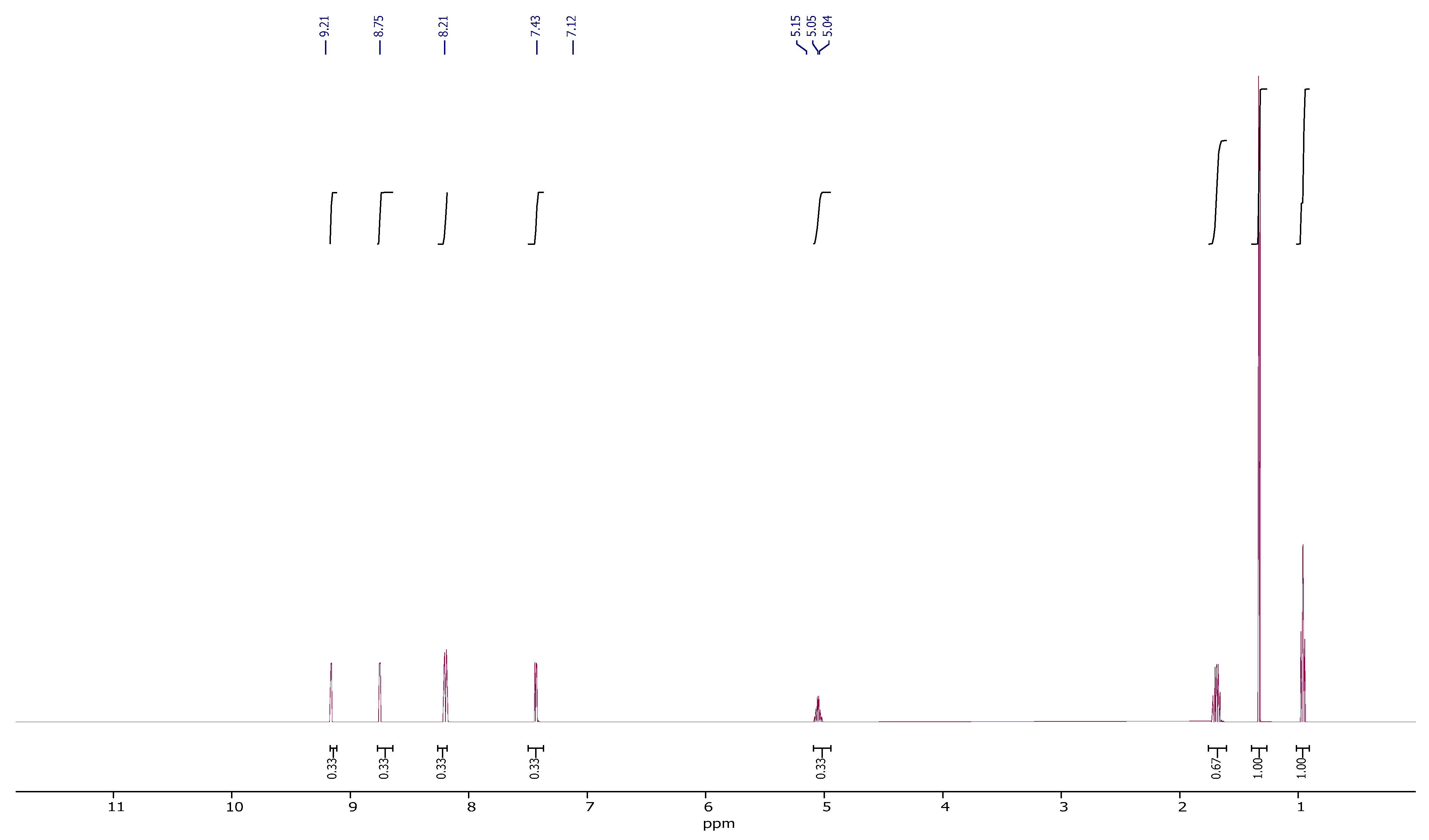


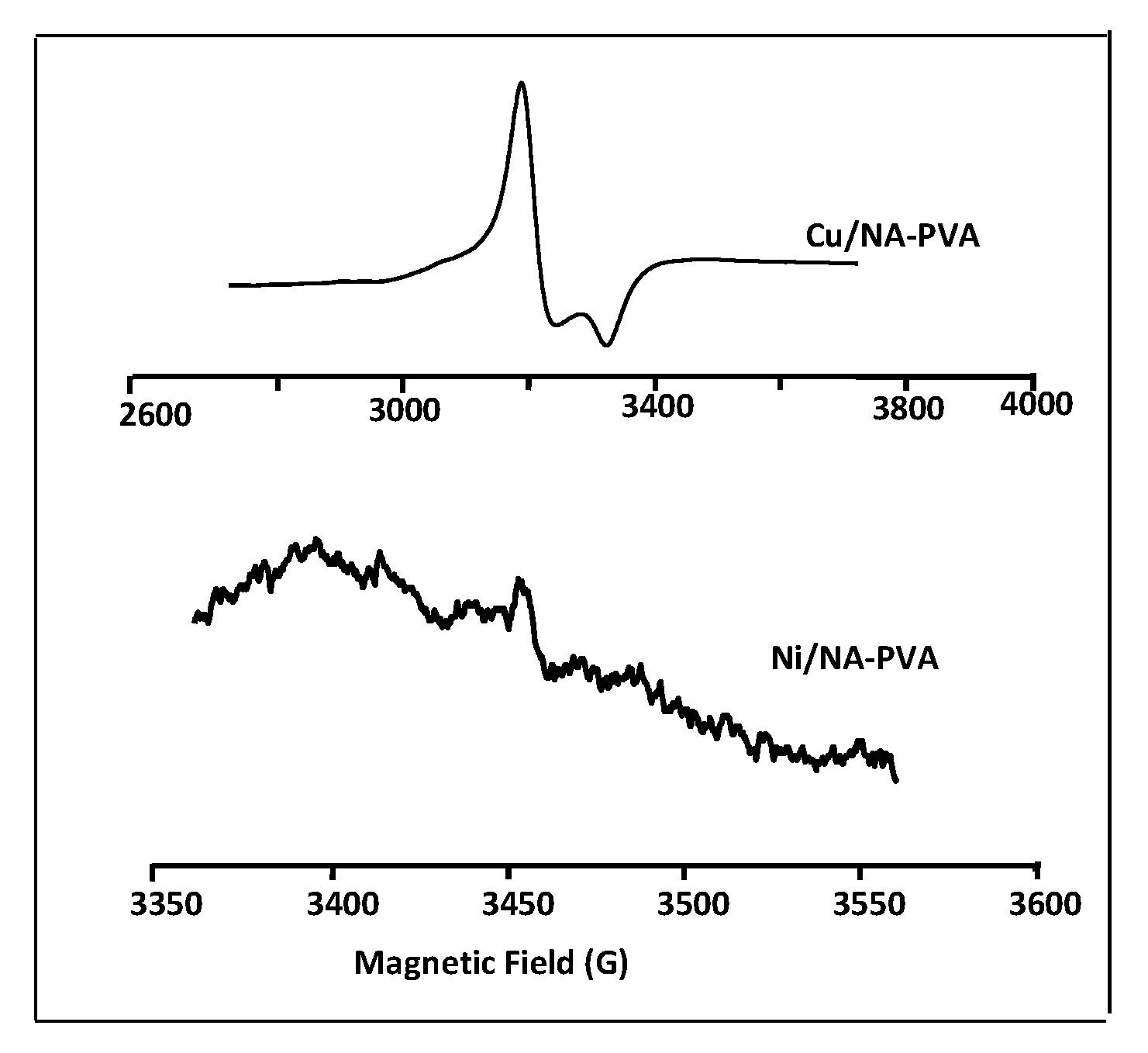


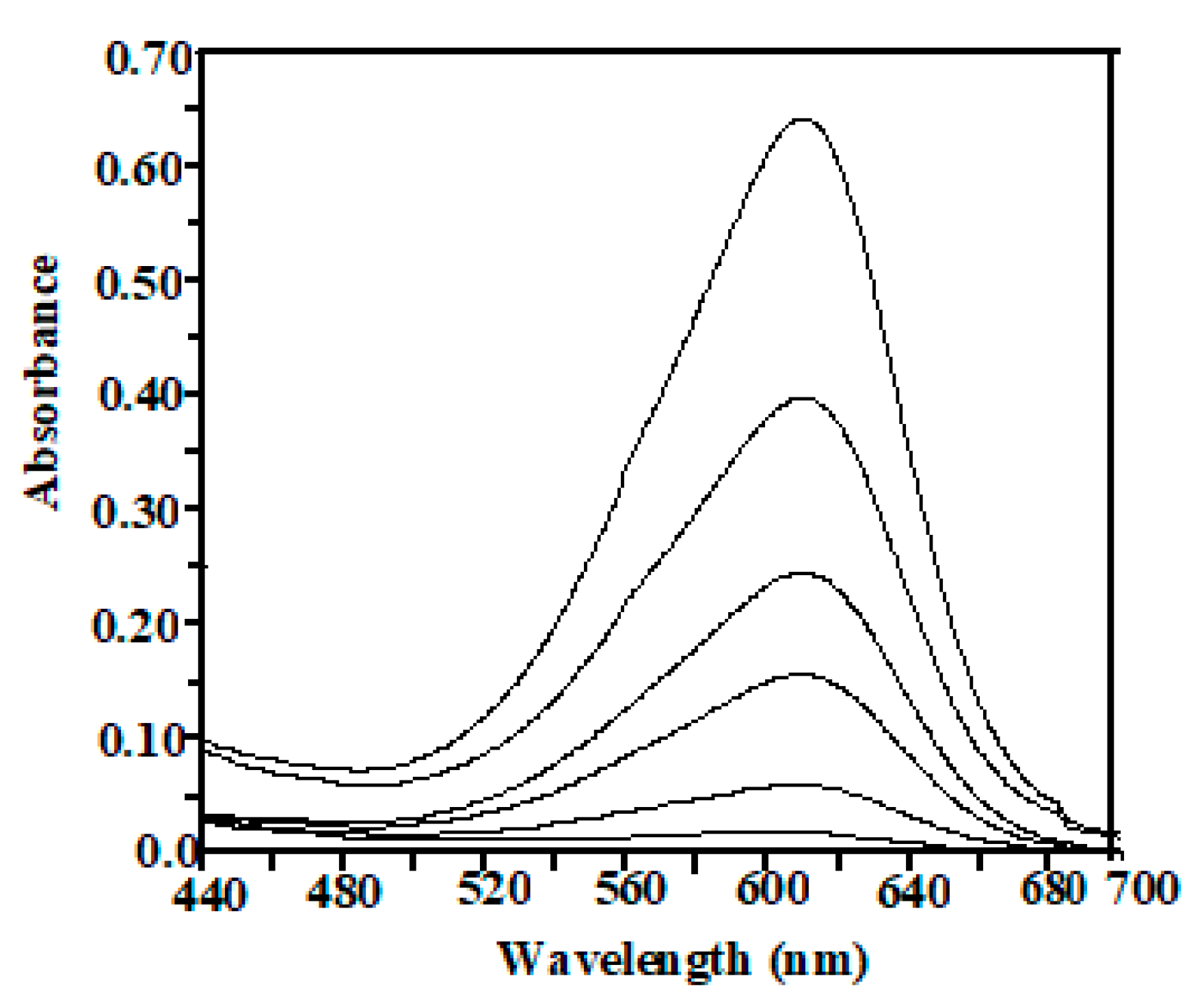
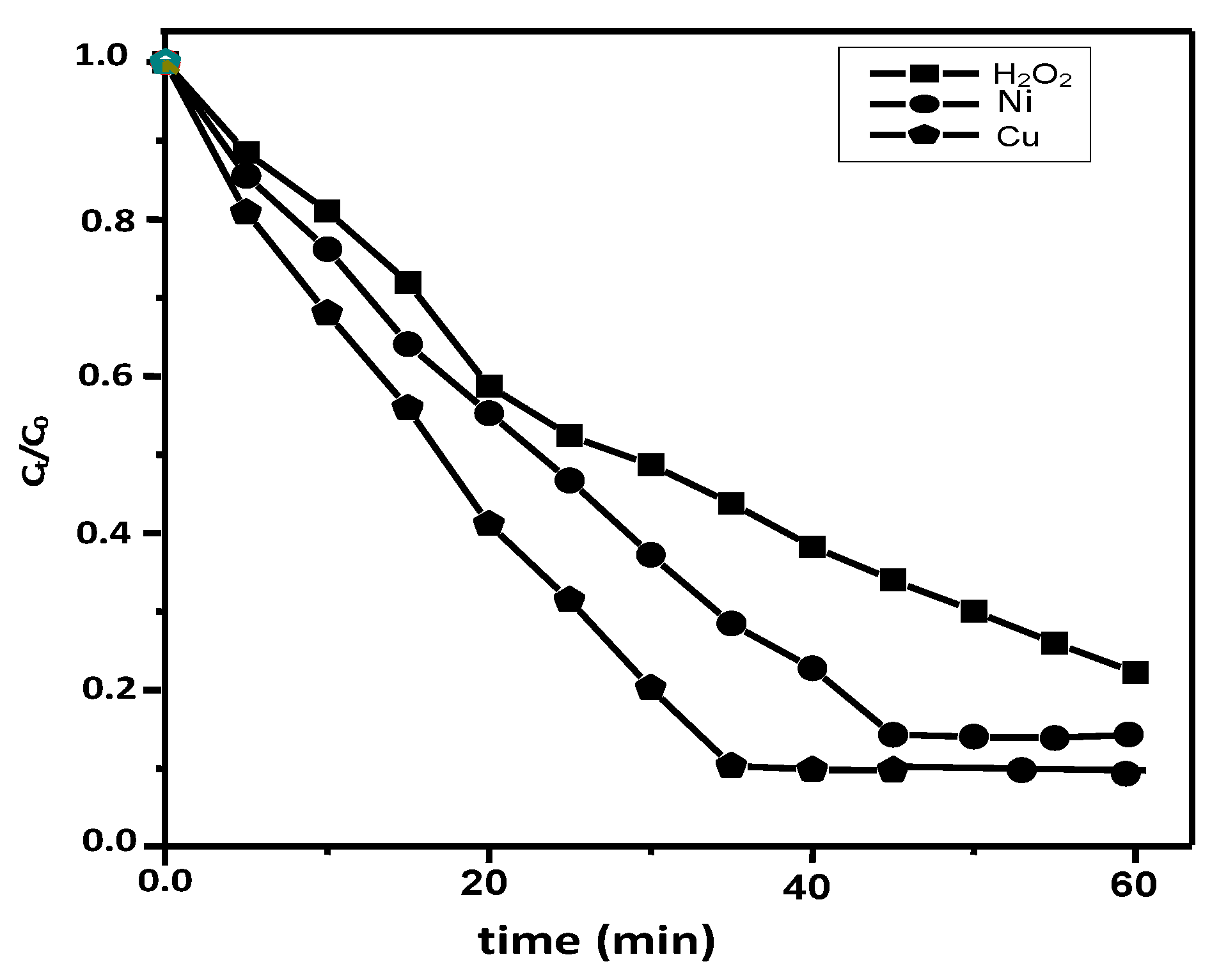

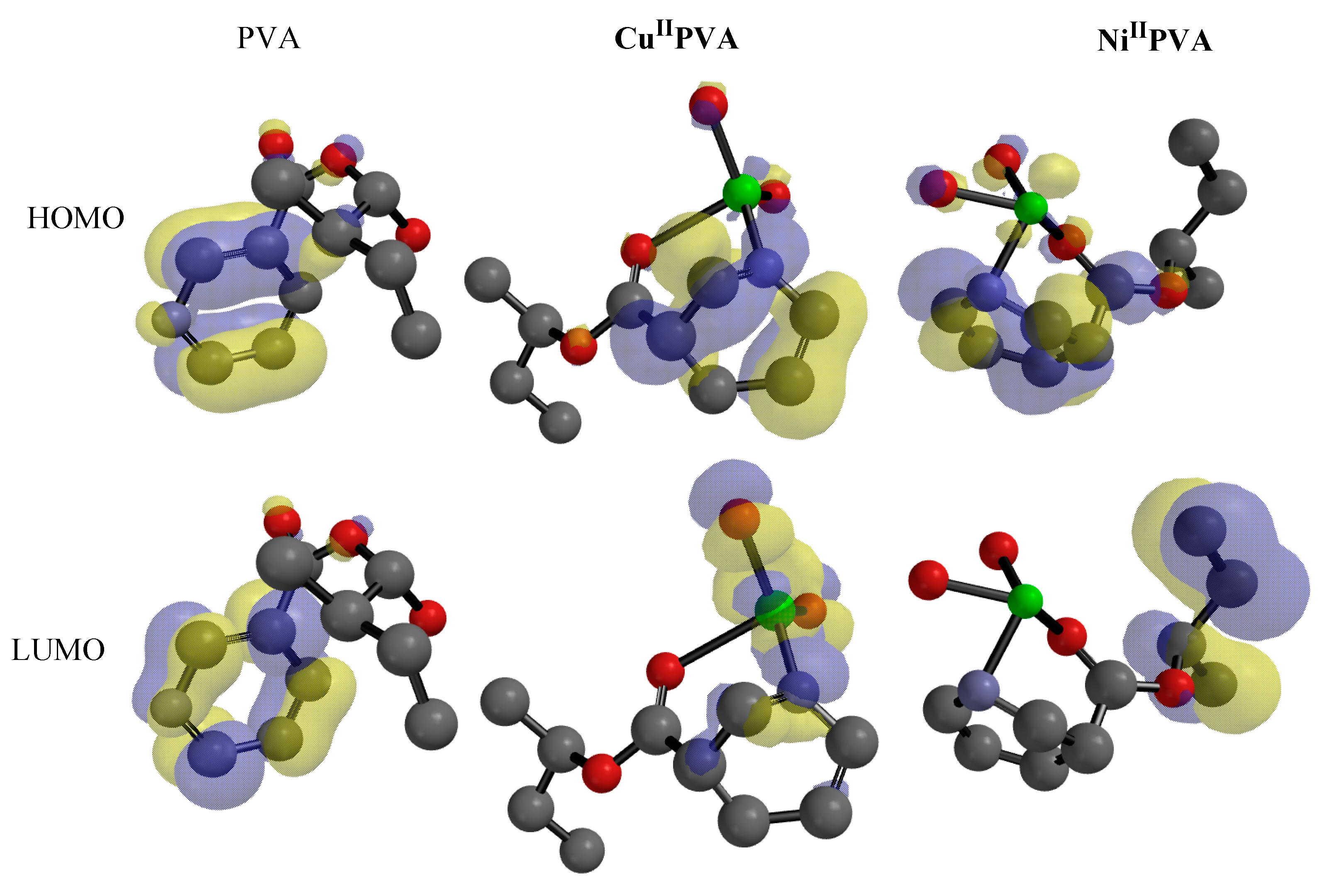



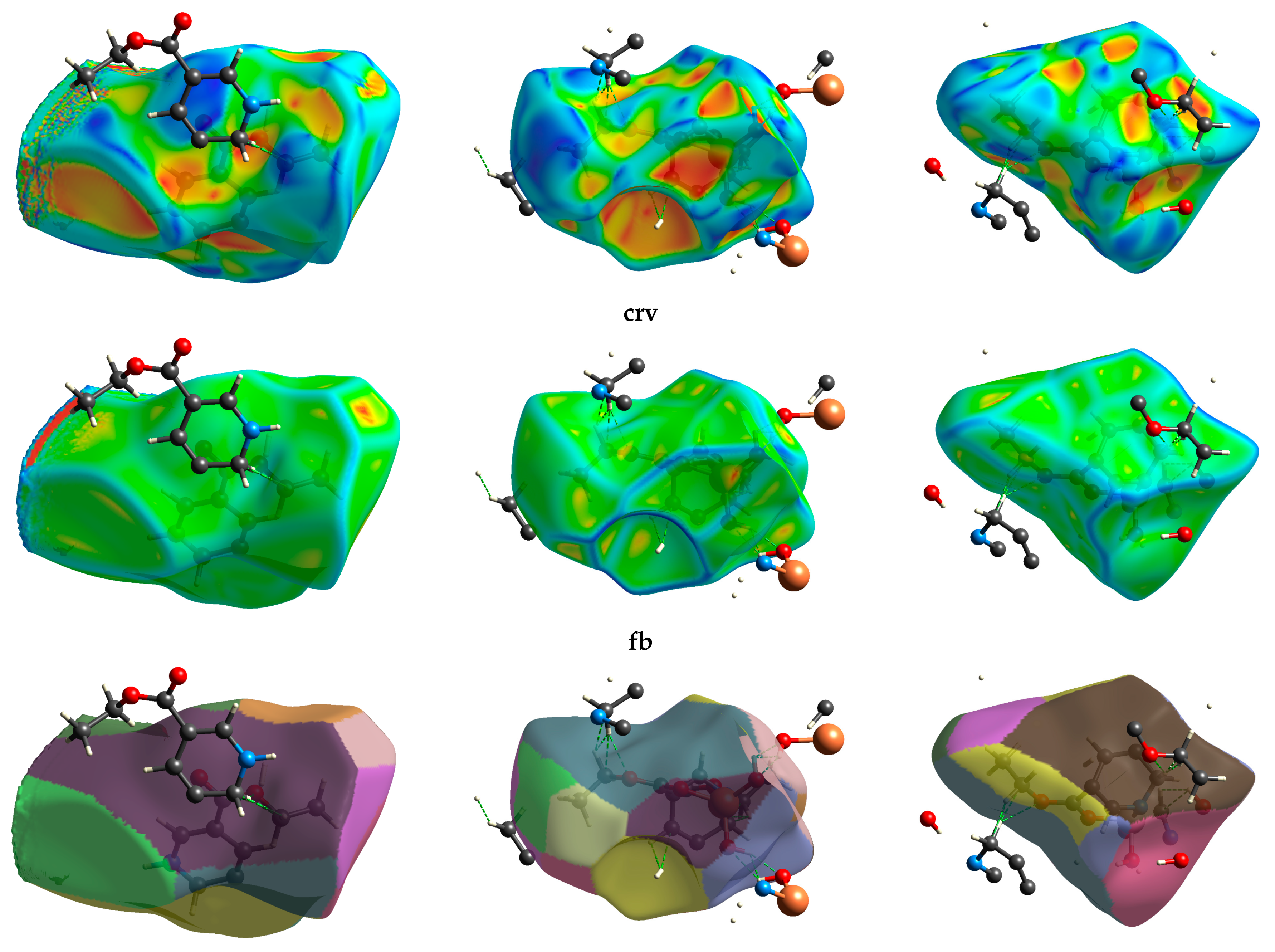
| Samples | Step | T/K | A/S−1 | E /KJ mol−1 | R2 | ΔH* /KJmol−1 | ΔS* /KJ mol−1 K−1 | ΔG* /KJmol−1 |
|---|---|---|---|---|---|---|---|---|
| NA-PVA | First | 466 | 3.3 × 1015 | 170.45 | 0.97 | 166.56 | 0.106 | 117.06 |
| Second | 626 | 3.01 × 10−58 | 821.12 | 0.97 | 815.91 | 0.43 | 541.52 | |
| Third | 708 | 1.2 × 10115 | 1707.34 | 0.97 | 1701.45 | −0.13 | 1794.40 | |
| Ni/NA-PVA | First | 455 | 2.5 × 1013 | 147.24 | 0.97 | 134.45 | 0.06 | 113.58 |
| Second | 627 | 6.3 × 1071 | 954.00 | 0.97 | 948.78 | 0.57 | 586.50 | |
| Third | 697 | 3.6 × 1075 | 1121.58 | 0.96 | 1115.77 | −0.13 | 1209.67 | |
| Cu/NA-PVA | First | 384 | 2.76 × 1013 | 124.46 | 0.996 | 121.26 | 0.067 | 95.252 |
| Second | 475 | 1.02 × 109 | 114.92 | 0.998 | 110.96 | −0.01 | 119.974 | |
| Third | 526 | 1.94 × 1027 | 311.19 | 0.953 | 306.80 | 0.33 | 132.881 | |
| Four | 639 | 6.24 × 1059 | 855.35 | 0.987 | 850.03 | −0.13 | 937.052 | |
| Five | 718 | 9.4 × 10118 | 1758.72 | 0.977 | 1752.74 | 1.05 | 996.983 |
| Samples | Step | T/K | A/S−1 | E /KJ mol−1 | R2 | ΔH*/KJ mol−1 | ΔS* /KJ mol−1 K−1 | ΔG* /KJ mol−1 |
|---|---|---|---|---|---|---|---|---|
| NA-PVA | First | 466 | 1.3 × 1087 | 800.043 | 0.96 | 796.16 | 1.477 | 106.335 |
| Second | 626 | 0.311 | 0.001 | 0.97 | 0.0001 | −0.13 | 0.015 | |
| Third | 708 | 1.3 × 1052 | 743.680 | 0.97 | 737.79 | 0.803 | 169.400 | |
| Ni/NA-PVA | First | 455 | 3.5 × 1004 | 69.268 | 0.96 | 65.480 | −0.10 | 112.882 |
| Second | 627 | 1.1 × 1036 | 450.806 | 0.97 | 445.593 | 0.496 | 134.225 | |
| Third | 697 | 9.9 × 1035 | 519.123 | 0.96 | 513.326 | 0.494 | 168.396 | |
| Cu/NA-PVA | First | 384 | 2.1 × 1004 | 56.422 | 0.99 | 53.228 | −0.10 | 94.184 |
| Second | 475 | 2.7 × 102 | 54.474 | 0.998 | 50.518 | −0.14 | 119.337 | |
| Third | 526 | 2.7 × 1010 | 137.781 | 0.95 | 133.402 | 0.007 | 129.347 | |
| Four | 639 | 1.1 × 1029 | 391.437 | 0.98 | 386.124 | 0.362 | 154.441 | |
| Five | 718 | 1758.729 | 0.97 | 0.856 | 785.812 | 0.856 | 170.462 |
| Cpd. | PVE | Cu | Ni | Cpd. | PVE | Cu | Ni |
|---|---|---|---|---|---|---|---|
| E | −475.22 | −460.67 | −1190.71 | Ωi | 5.47 | 2.95 | 2.02 |
| HOMO | −10.41 | −3.72 | −3.58 | µ+ | −2.99 | −2.56 | −1.24 |
| LUMO | −0.52 | −2.17 | −0.46 | µ− | −7.94 | −3.33 | −2.80 |
| ΔG | −9.89 | −1.55 | −3.12 | Ω− | 6.37 | 7.16 | 2.51 |
| I | 10.41 | 3.72 | 3.58 | Ω+ | 2.40 | 5.50 | 1.11 |
| A | 0.52 | 2.17 | 0.46 | Ω± | 8.77 | 12.66 | 3.63 |
| η | 4.95 | 0.78 | 1.56 | ΔNmax | −0.55 | −1.90 | −0.65 |
| S | 0.20 | 1.29 | 0.64 | ΔρKNU | 14.80 | −39.25 | 14.80 |
| χ | −5.47 | −2.95 | −2.02 | ΔρKELE | 1.98 | −2.58 | 1.98 |
| Cpd. | PVE | Cu | Ni | Cpd. | PVE | Cu | Ni |
|---|---|---|---|---|---|---|---|
| ZPE | 210.474 | 632 | 173.62 | First order hyperpolarizability (β) | |||
| G° | 26.940 | 31.00 | 24.54 | βxxx | 43.275 | 414.85 | −434.3 |
| S° | 155.573 | 187.1 | 143.29 | βxyy | −21.683 | 637.40 | 108.3 |
| CV° | 137.541 | 173.82 | 122.90 | βxzz | 3.107 | −32.98 | −273.3 |
| Dipole moment (µ) | βyyy | 73.202 | −1326.10 | −591.8 | |||
| μx | 0.837 | −2.215 | 5.167 | βxxy | −5.484 | −178.39 | −173.0 |
| μy | −1.050 | −1.880 | −0.819 | βyzz | 5.606 | 35.62 | 181.1 |
| μz | 0.676 | 0.228 | 0.242 | βzzz | −20.301 | −276.35 | −154.6 |
| μ | 3.820 | 7.408 | 13.311 | βxyz | −5.203 | 132.43 | 341.6 |
| Polarizability (α) | βyyz | −9.152 | 638.36 | −434.3 | |||
| αxx | 90.894 | 151.622 | 204.1126 | β0 | −0.275 | 2.618 | −18.177 |
| αyy | 105.193 | 167.854 | 205.3385 | ||||
| αzz | 96.175 | 156.137 | 119.0984 | ||||
| αxz | 18.405 | −29.312 | −22.04 | ||||
| αxy | 3.145 | 11.501 | −7.19 | ||||
| αyz | −3.406 | 12.729 | −25.99 | ||||
| α0 | 2.887 | 4.698 | 5.22 | ||||
| ∆α | 9.79 | 40.22 | 43.83 | ||||
Publisher’s Note: MDPI stays neutral with regard to jurisdictional claims in published maps and institutional affiliations. |
© 2021 by the authors. Licensee MDPI, Basel, Switzerland. This article is an open access article distributed under the terms and conditions of the Creative Commons Attribution (CC BY) license (https://creativecommons.org/licenses/by/4.0/).
Share and Cite
Ali, I.O.; Nassar, H.S.; Naglah, A.M.; Al-Harbi, L.M.; Elhenawy, A.A. Structural and Spectroscopic Characteristics of NiII and CuII Complexes with Poly (Vinyl Alcohol-Nicotinic Acid) Copolymers for Photocatalytic Degradation of Indigo Carmine Dye. Crystals 2021, 11, 1244. https://doi.org/10.3390/cryst11101244
Ali IO, Nassar HS, Naglah AM, Al-Harbi LM, Elhenawy AA. Structural and Spectroscopic Characteristics of NiII and CuII Complexes with Poly (Vinyl Alcohol-Nicotinic Acid) Copolymers for Photocatalytic Degradation of Indigo Carmine Dye. Crystals. 2021; 11(10):1244. https://doi.org/10.3390/cryst11101244
Chicago/Turabian StyleAli, Ibraheem O., Hisham S. Nassar, Ahmed M. Naglah, Laila M. Al-Harbi, and Ahmed A. Elhenawy. 2021. "Structural and Spectroscopic Characteristics of NiII and CuII Complexes with Poly (Vinyl Alcohol-Nicotinic Acid) Copolymers for Photocatalytic Degradation of Indigo Carmine Dye" Crystals 11, no. 10: 1244. https://doi.org/10.3390/cryst11101244
APA StyleAli, I. O., Nassar, H. S., Naglah, A. M., Al-Harbi, L. M., & Elhenawy, A. A. (2021). Structural and Spectroscopic Characteristics of NiII and CuII Complexes with Poly (Vinyl Alcohol-Nicotinic Acid) Copolymers for Photocatalytic Degradation of Indigo Carmine Dye. Crystals, 11(10), 1244. https://doi.org/10.3390/cryst11101244






